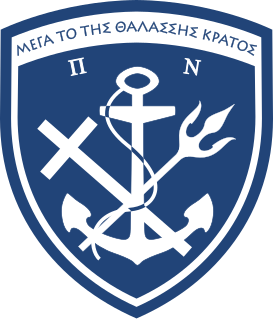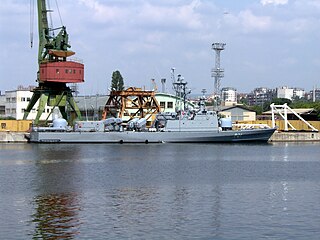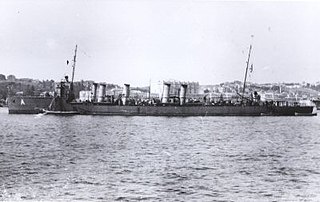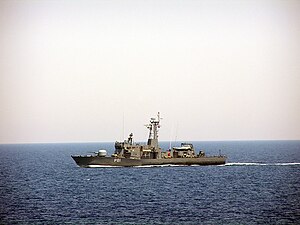
The Hellenic Navy is the naval force of Greece, part of the Hellenic Armed Forces. The modern Greek navy historically hails from the naval forces of various Aegean Islands, which fought in the Greek War of Independence. During the periods of monarchy it was known as the Royal Hellenic Navy.
A patrol boat is a relatively small naval vessel generally designed for coastal defence, border protection, immigration law-enforcement, search and rescue duties. There have been many designs for patrol boats. They may be operated by a nation's navy, coast guard, police force or customs and may be intended for marine or estuarine or river environments. They are commonly found engaged in various border protection roles, including anti-smuggling, anti-piracy, fisheries patrols, and immigration law enforcement. They are also often called upon to participate in rescue operations.
Hellenic Shipyards S.A. is a large shipyard in Skaramagas, in West Athens regional unit, Greece.

The Hellenic Coast Guard is the national coast guard of Greece. Like many other coast guards, it is a paramilitary organization that can support the Hellenic Navy in wartime, but resides under separate civilian control in times of peace. It was founded in 1919 by an Act of Parliament and the legal framework for its function was reformed in 1927. Its primary mission is the enforcement of Greek, European and International law in the maritime areas.
The History of the Hellenic Navy begins with the birth of modern Greece, and due to the maritime nature of the country, this force has been the premier service of the Greek Armed Forces.

The OTO Melara 76 mm gun is a naval gun built and designed by the Italian defence company Oto Melara. It is based on the Oto Melara 76/62C and evolved toward 76/62 SR and 76/62 Strales.

The Hellenic Merchant Navy refers to the merchant navy of Greece, engaged in commerce and transportation of goods and services universally. It consists of the merchant vessels owned by Greek civilians, flying either the Greek flag or a flag of convenience. As of 2020, Greece is the largest ship owner country in the world in terms of tonnage; with a total deadweight tonnage of 364 million tons and 4,901 Greek-owned vessels. Greece is a maritime nation by tradition, as shipping is arguably the oldest form of occupation of the Greeks and a key element of Greek economic activity since the ancient times. Today it is the second largest contributor to the national economy after tourism. The Greek fleet flies a variety of flags; however, some Greek shipowners gradually return to Greece following the changes to the legislative framework governing their operations and the improvement of infrastructure.

Adrias was a Type III Hunt-class destroyer that was originally built for the Royal Navy as HMS Border but never commissioned. Before her completion, she was loaned to the Royal Hellenic Navy on 20 July 1942 and commissioned as Adrias on 5 August 1942 in order to relieve heavy losses of ships sustained by the Royal Hellenic Navy during the German invasion of 1941 and throughout the war. Adrias took her name from the ancient Greek town of Adria in Italy, at the mouth of the Po river, after which the Adriatic Sea is named.

The La Combattante III type missile boats of the Hellenic Navy are a class of four fast attack craft ordered by Greece in September 1974 from France. The vessels had no class name but are referred to by type. They are similar to the La Combattante IIa-class fast attack craft already in service, but are larger and armed with torpedoes. A second group of six were ordered in 1978, to be built under license in Greece and use Penguin Mk 2 Mod 3 missiles. Since 2019, all the ships of the class use Harpoon anti-ship missiles.

The Zubr class is a class of Soviet-designed air-cushioned landing craft (LCAC). The name "Żubr" is Polish for the European bison. This class of military hovercraft is, as of 2012, the world's largest, with a standard full load displacement of 555 tons. The hovercraft was designed to sealift amphibious assault units from equipped/non-equipped vessels to non-equipped shores, as well as to transport and plant naval mines.

The Osprey 55-class gunboat is a Danish-designed class of naval ship currently in service in the Hellenic Navy and Royal Moroccan Navy. Two ships were ordered by Greece in March 1988 and built by Hellenic Shipyards. The first one was laid down on 8 May 1989 and launched on 19 December 1989. The second ship was laid down on 9 November 1989 and launched on 16 May 1990. Armament is of modular design and therefore can be changed. 76-millimetre (3 in) guns replaced the Bofors 40 mm (1.6 in) guns in 1995, after being taken from decommissioned Gearing-class destroyers. Options on more of the class were shelved in favour of the slightly larger HSY-55 class.

The Osprey HSY-56A-class gunboat is a class of naval vessel currently in service in the Hellenic Navy. These ships are similar to HSY-55-class gunboat and were also built by Hellenic Shipyards (HSY). They are the most modern patrol vessels of Hellenic Navy. The first ship of the class named Machitis was commissioned on 29 October 2003. In 2018 all of the four ships of the class are in active service.

Aetos was an Aetos-class destroyer which served in the Royal Hellenic Navy from 1912–1945.

USS Pelican (MHC-53) was the third Osprey-class coastal minehunter and the third ship in the Navy to bear the name of the bird. From 1 January 1997 on, Pelican was part of the Naval Reserve Force. In that role the ship was used as training platform for naval reservists. Both decommissioned and stricken from the Navy List on 16 March 2007, Pelican was transferred to the Hellenic Navy the same day. There she was recommissioned as Evniki.
Y-1 Katsonis was a Greek submarine active during the Second World War. Katsonis, together with her sister ship, Papanikolis, formed the first class of Greek submarines ordered after the First World War. The submarine was built at the Forges et Chantiers de la Gironde shipyard, in Bordeaux, between 1925–27, and commissioned into the Hellenic Navy on 8 June 1928. Her first captain was Cdr Κ. Arvanitis.

The Hydra class are a group of four frigates in service with the Hellenic Navy. They were designed in Germany and are part of the MEKO group of modular warships, in this case the MEKO 200 design.

Hydra (F-452) is the lead ship of the Greek Hydra-class frigate and flagship of the Hellenic Navy. The ship was built in the same shipyard as the Blohm + Voss MEKO 200 frigate class, on which its design was based. Three more vessels were built by Hellenic Shipyards Co. at Skaramagas in following years. It is the fifth ship in the Hellenic Navy to bear the name Hydra.

The Roussen class is a seven-strong class of British-designed fast attack missile boats improved and customized for the Hellenic Navy, also known as Super Vita. The class is named after its lead ship, which in turn is named after Lt Nikolaos Roussen, a World War II submarines officer who was killed in the suppression of the Navy mutiny in April 1944.

USS Beacon (PGM-99/PG-99) was an Asheville-class gunboat in the United States Navy during the Vietnam War. She was transferred to the Hellenic Navy where she serves as PG Hormi.















